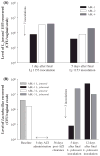A Chinese rhesus macaque (Macaca mulatta) model for vaginal Lactobacillus colonization and live microbicide development
- PMID: 19367737
- PMCID: PMC4422182
- DOI: 10.1111/j.1600-0684.2008.00316.x
A Chinese rhesus macaque (Macaca mulatta) model for vaginal Lactobacillus colonization and live microbicide development
Abstract
Background: We sought to establish a nonhuman primate model of vaginal Lactobacillus colonization suitable for evaluating live microbial microbicide candidates.
Methods: Vaginal and rectal microflora in Chinese rhesus macaques (Macaca mulatta) were analyzed, with cultivable bacteria identified by 16S rRNA gene sequencing. Live lactobacilli were intravaginally administered to evaluate bacterial colonization.
Results: Chinese rhesus macaques harbored abundant vaginal Lactobacillus, with Lactobacillus johnsonii as the predominant species. Like humans, most examined macaques harbored only one vaginal Lactobacillus species. Vaginal and rectal Lactobacillus isolates from the same animal exhibited different genetic and biochemical profiles. Vaginal Lactobacillus was cleared by a vaginal suppository of azithromycin, and endogenous L. johnsonii was subsequently restored by intravaginal inoculation. Importantly, prolonged colonization of a human vaginal Lactobacillus jensenii was established in these animals.
Conclusions: The Chinese rhesus macaque harbors vaginal Lactobacillus and is a potentially useful model to support the pre-clinical evaluation of Lactobacillus-based topical microbicides.
Figures




Similar articles
-
Demonstration of vaginal colonization with GusA-expressing Lactobacillus jensenii following oral delivery in rhesus macaques.Res Microbiol. 2011 Dec;162(10):1006-10. doi: 10.1016/j.resmic.2011.08.003. Epub 2011 Aug 29. Res Microbiol. 2011. PMID: 21907793 Free PMC article.
-
Comparison of the vaginal environment in rhesus and cynomolgus macaques pre- and post-lactobacillus colonization.J Med Primatol. 2017 Oct;46(5):232-238. doi: 10.1111/jmp.12264. Epub 2017 May 9. J Med Primatol. 2017. PMID: 28488364 Free PMC article.
-
In vivo evaluation of safety and toxicity of a Lactobacillus jensenii producing modified cyanovirin-N in a rhesus macaque vaginal challenge model.PLoS One. 2013 Nov 12;8(11):e78817. doi: 10.1371/journal.pone.0078817. eCollection 2013. PLoS One. 2013. PMID: 24265721 Free PMC article.
-
Lactobacillus and Pediococcus species richness and relative abundance in the vagina of rhesus monkeys (Macaca mulatta).J Med Primatol. 2012 Jun;41(3):183-90. doi: 10.1111/j.1600-0684.2012.00537.x. Epub 2012 Mar 20. J Med Primatol. 2012. PMID: 22429090 Free PMC article.
-
Directed shift of vaginal microbiota induced by vaginal application of sucrose gel in rhesus macaques.Int J Infect Dis. 2015 Apr;33:32-6. doi: 10.1016/j.ijid.2014.12.040. Epub 2014 Dec 26. Int J Infect Dis. 2015. PMID: 25546169
Cited by
-
Microbial biofilms on the surface of intravaginal rings worn in non-human primates.J Med Microbiol. 2011 Jun;60(Pt 6):828-837. doi: 10.1099/jmm.0.028225-0. Epub 2011 Mar 10. J Med Microbiol. 2011. PMID: 21393449 Free PMC article.
-
Longitudinal assessment of pigtailed macaque lower genital tract microbiota by pyrosequencing reveals dissimilarity to the genital microbiota of healthy humans.AIDS Res Hum Retroviruses. 2012 Oct;28(10):1244-9. doi: 10.1089/AID.2011.0382. Epub 2012 May 3. AIDS Res Hum Retroviruses. 2012. PMID: 22264029 Free PMC article.
-
A case control study of anovaginal distance and bacterial vaginosis.Int J STD AIDS. 2011 Apr;22(4):231-3. doi: 10.1258/ijsa.2011.010307. Int J STD AIDS. 2011. PMID: 21515758 Free PMC article.
-
The Vaginal Microbiome of Nonhuman Primates Can Be Only Transiently Altered to Become Lactobacillus Dominant without Reducing Inflammation.Microbiol Spectr. 2021 Dec 22;9(3):e0107421. doi: 10.1128/Spectrum.01074-21. Epub 2021 Nov 10. Microbiol Spectr. 2021. PMID: 34756073 Free PMC article.
-
Bioactive Peptides Produced by Cyanobacteria of the Genus Nostoc: A Review.Mar Drugs. 2019 Sep 29;17(10):561. doi: 10.3390/md17100561. Mar Drugs. 2019. PMID: 31569531 Free PMC article. Review.
References
-
- Antonio MA, Hawes SE, Hillier SL. The identification of vaginal Lactobacillus species and the demographic and microbiologic characteristics of women colonized by these species. J Infect Dis. 1999;180:1950–6. - PubMed
-
- Antonio MA, Rabe LK, Hillier SL. Colonization of the rectum by Lactobacillus species and decreased risk of bacterial vaginosis. J Infect Dis. 2005;192:394–8. - PubMed
-
- Baron EJ, Vaisanen ML, McTeague M, Strong CA, Norman D, Finegold SM. Comparison of the Accu-CulShure system and a swab placed in a B-D Port-a-Cul tube for specimen collection and transport. Clin Infect Dis. 1993;16:S325–7. - PubMed
-
- Boskey ER, Cone RA, Whaley KJ, Moench TR. Origins of vaginal acidity: high D/L lactate ratio is consistent with bacteria being the primary source. Hum Reprod. 2001;16:1809–13. - PubMed
Publication types
MeSH terms
Substances
Grants and funding
LinkOut - more resources
Full Text Sources

